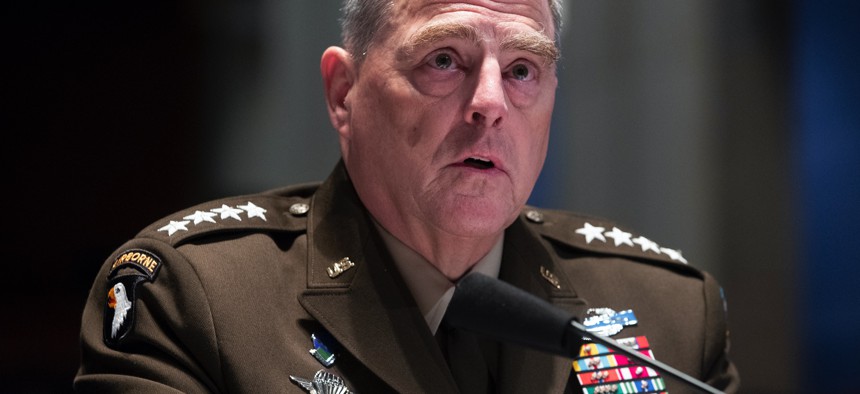
Chairman of the Joint Chiefs of Staff Gen. Mark Milley testifies to the House Armed Services Committee earlier this year. Michael Reynolds/Pool via AP, File
US Has Achieved ‘Modicum of Success’ in Afghanistan, Top General Says
But years of military stalemate make negotiating with the Taliban the only option, Gen. Mark Milley says.
Two decades of war in Afghanistan have seen a “modicum of success” but also years of “strategic stalemate,” the nation’s top general said Wednesday in one of the military’s frankest assessments of progress in the wartorn nation in recent memory.
The United States has been successful at preventing another 9/11-style attack from originating in Afghanistan, Gen. Mark Milley said during an online Brookings event, through its model of training and supporting the Afghan military and working with the government in Kabul.
"We believe that after two decades of consistent effort, we've achieved a modicum of success,” Milley said. “I would also argue over the last five to seven years at a minimum, we have been in a condition of strategic stalemate.”
Because neither the Taliban nor the government of Afghanistan—backed by the U.S.—was going to be victorious on the battlefield, Milley said, “the only way that war should or could come to an end that was somewhat in alignment with U.S. national security interests—and also in the interests of the people of the region—was through a negotiated settlement.”
Milley acknowledged that negotiating with the Taliban was “odious” to some Americans, but argued that most insurgencies end with some form of negotiated settlement.
The Army four-star’s tone was notably different from the usual sunny Pentagon assessments of “progress” in Afghanistan. Since the 2001 invasion, various military officials have cited “significant progress,” “tangible progress,” and “interesting progress” in Afghanistan, while the repeated contention that the United States is “turning a corner” there has become the butt of jokes.
President Trump has ordered an accelerated withdrawal of U.S. troops, down to 2,500, before President-elect Joe Biden takes office on Jan. 20. Critics say the move could endanger the remaining U.S. troops and strengthen the Taliban's negotiating hand. Advocates have hailed it as a necessary recognition of reality: that the two-decade conflict is no longer worth its price in American blood and treasure.
On Wednesday, Milley gave a few details about how the remaining U.S. presence would be structured. The plans were based on recommendations made to and approved by Acting Defense Secretary Chris Miller. They were drawn up by the commander of U.S. Central Command, Gen. Frank McKenzie, and the commander of U.S. forces in Afghanistan, Gen. Scott Miller.
"You're looking at a couple of larger bases with several satellite bases that provide the capability to continue our counterterrorism mission and our train, advise and assist mission,” Milley said, while declining to offer specifics on which U.S. bases would be shuttered as part of the drawdown.
"What comes after that, that will be up to a new administration,” Milley said — a notable remark in light of Trump’s ongoing and, so far, baseless contestation of the 2020 election results.
Milley also confirmed that the Pentagon is weighing the current U.S. presence in Somalia, amid rumors and reports that Trump is considering withdrawing all forces from the East African nation. Somalia, Milley said, “is an ongoing debate right this minute.
“Not so much as to what a footprint is, it's what the footprint will look like,” he said. “We're taking a hard look at the repositioning of the force” to better counter the terrorist group al-Shabab. Shabab, he said, has “some reach” and if left unaddressed, could launch attacks on U.S. interests in the region or even on the U.S. homeland.
Milley is in his second year as chairman of the Joint Chiefs, and unless he is removed by either the outgoing administration or the incoming president-elect, will continue to serve as the new president’s top military advisor.




